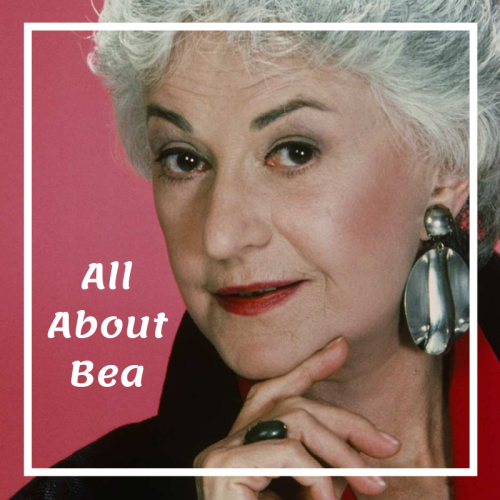
Welcome to All About Bea, a six-part series exploring the life and times of the one and only Bea Arthur!
Over the past year of writing this blog I’ve researched various events in the lives of each of The Golden Girls, and one thing that stood out to me was that Bea Arthur’s career really hasn’t received the attention it deserves. Often described as an introvert in her private life by herself and those who knew her, Bea never wrote any books about her life as her co-stars did. So even though the dates and details are all out there for anyone who wants to find them, I aim to give Bea’s life more context by putting it all together with my own research, visual material, and quotes from Bea herself. I hope you’ll enjoy learning more about Bea Arthur as much as I have!
My dream was to become a very small, blonde movie star like Ida Lupino and those other women I saw up there on the screen during the Depression.
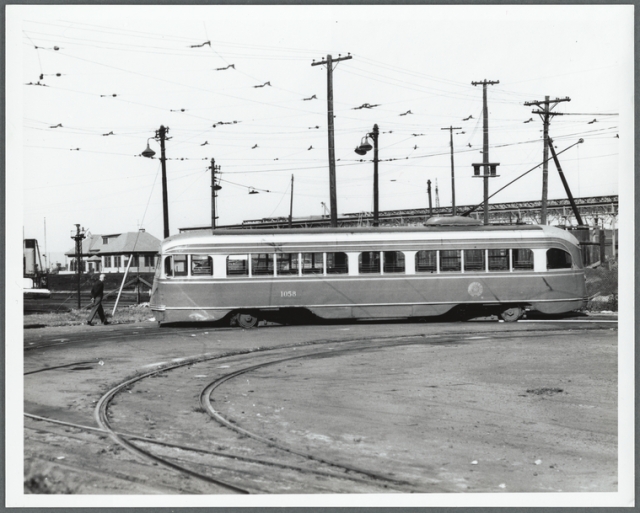
On May 13, 1922 Bea Arthur was born as Bernice Frankel in Brooklyn, New York to parents Rebecca and Phillip. She joined an older sister, Gertrude, and a younger sister, Marian (Kay), would complete the family in 1926. Bea’s parents immigrated from Austria and Poland, respectively. Brooklyn experienced vast urbanization and expansion throughout the early 20th century and in the 1920’s, including transportation developments like the streetcar above and further industrialization. Nevertheless, after some financial trouble during the Great Depression, the Frankel family moved to Cambridge, Maryland in 1933 and opened a store selling women’s clothes.

Life in Cambridge was quite different from Brooklyn as there were few other Jewish families in the town. Bea described herself as a “painfully shy” child and a “misfit,” but it was also during this time that her silver screen dreams began to take shape. She spent many hours reading movie magazines and, tellingly, honed a Mae West impersonation that won her the title of Wittiest Girl in her high school class.
After graduating, it seems that Bea bounced around for a little while, moving back to New York and working as a lab technician and in an office. She had trouble supporting herself at that time so, during World War II in 1943, she decided to enlist with the United States Marines in the newly formed Women’s Reservists unit. She became Private Frankel, and later petitioned to change her name to Aurthur (updated to Arthur for the stage) after marrying her first husband and fellow Marine, Robert Aurthur. She worked as a truck driver and a typist before receiving an honorable discharge with the rank of Staff Sargent in 1944. Some accounts of Bea’s life report that she denied having served in the Marines. This seems to be based mostly on an interview she gave in 2001 in which she does respond, “Oh, no, no…” when asked about her service. But, if you watch closely, you can detect a glint in her eye and a sly tilt of her head indicating that she’s more avoiding the question rather than denying it. This part of her life is also completely omitted from her 2002 Lifetime Intimate Portrait episode, so the confusion is understandable. I think she just simply didn’t like talking about that era, which seems reasonable considering how her life as an actress quickly began to blossom after she was discharged.
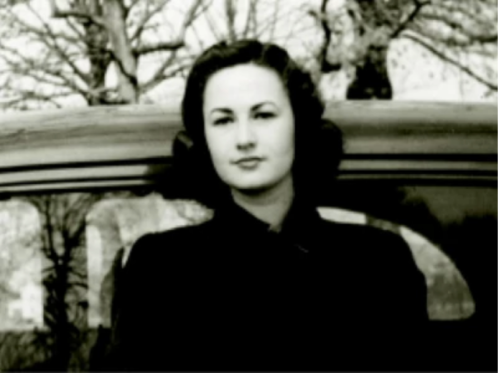
In 1947, Bea began studying acting formally at the famed New School in New York City with Erwin Piscator and became a member of an off-Broadway theater group at the Cherry Lane Theater. She also met and fell in love with a fellow classmate, Gene Saks. The two married on May 28, 1950. During this time she was cast in classical plays such as Taming of the Shrew and Clytemnestra. Comedic bit parts on television shows hosted by Sid Caesar, Perry Como, and others also helped to pay the rent. You can see her in the clip below starting at the 35-minute mark. She sang in night clubs like the Blue Angel around this time, too.
Bea’s first big break came in 1954 when she was cast in the role of Lucy Brown in the English language adaptation of Kurt Weill‘s The Threepenny Opera at the Theater de Lys. You can listen to her universally acclaimed performance on the cast recording. Her trademark wit and comic timing is on full display in the song, “Jealousy Duet.” One of the reasons I wish Bea would have written a memoir is so we could hear from her what it was like to work with the great Lotte Lenya, especially at such a pivotal point in her career. Lenya originated the role of Pirate Jenny, in the original German Threepenny Opera, and reprised it in the English adaptation, for which she won a Tony award. Also starring in this groundbreaking production were two other actors who would become well-known on television, Charlotte Rae and John Astin. Bea noted in the Intimate Portrait episode that it was in this role that she truly discovered her comedic talent when the audience laughed at her performance of the “Barbara Song.”
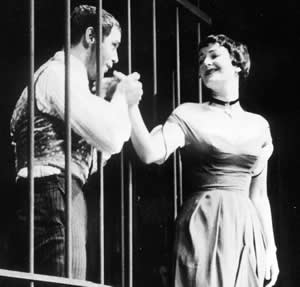
This had to be a thrilling time in Bea’s life, when all her acting dreams were beginning to come true. While many sources (including Wikipedia) cite her Broadway debut as The Threepenny Opera, that role is considered Off-Broadway (even though it did win two Tony awards), since the theater was located on Christopher Street in Greenwich Village. In early 1955 she was an understudy in the Broadway premiere of the musical, Plain and Fancy, which also starred another theater legend, Barbara Cook. As far as I can tell, her true Broadway debut as a principal cast member came in the original musical, Seventh Heaven, which opened in May of 1955 and also starred Ricardo Montalban and Chita Rivera. Although Seventh Heaven was a flop, Bea continued to act in many plays and musicals throughout the 1950’s, in what was obviously a formative time in her great career.
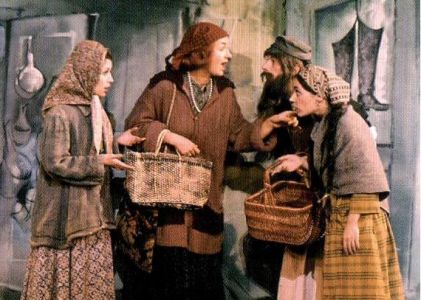
By the 1960’s Bea had established herself in New York’s theater world, and in 1964 she was cast as Yente, the matchmaker, in the Broadway premiere of Fiddler on the Roof. The show’s famed director and choreographer, Jerome Robbins, was well known for being difficult to work with. Bea would recall years later in her own Broadway show that he was the only director who ever made her cry and that “he was really a dreadful human being.” Tanya Everett (who played the part of one of the daughters, Chava) notes in Tradition! by Barbara Isenberg that Bea “was ready to quit before we got to Broadway, but she really believed in the show.” Despite this, Bea owned the role of Yente and made it her own. Fiddler on the Roof has been one of the most successful musicals of all time since its premiere. It ran for over 3,000 performances, becoming the first musical to do so at that time, and won nine Tony awards. The musical’s universal themes of life, love, and generational change continue to resonate with audiences all over the world. Bea also had personal success during this time as she and Gene adopted their children, Matthew and Daniel, in the early 1960’s.
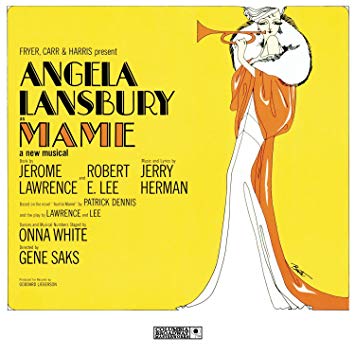
In 1966, Bea became bonafide Broadway royalty with her role as Vera Charles in Mame alongside Angela Lansbury. The musical was directed by her husband and based on the book, Auntie Mame, by Patrick Dennis, as well as a previous Broadway play and the film of the same name from 1958 (starring Rosalind Russell). Bea had originally auditioned for the role of Mame and was somewhat disappointed to be cast in the supporting role, but listening to the cast recording proves that the character of Vera was a perfect fit for her talents as a singer and comedic actress. She ended up winning the Tony award for Best Featured Actress in a Musical with Lansbury winning for Leading Actress. The two women also became close, lifelong friends. After Mame, Bea took a bit of a break to spend more time at home with the boys while Gene branched out to direct films.
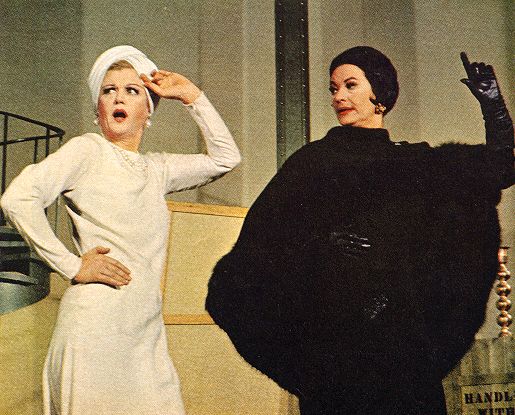
By the end of the 1960’s Bea was a Broadway star who was poised for even greater fame. I really loved learning more about this early period of Bea’s career. She was not an overnight success, but that happens so rarely that I think it’s almost unfair to tack that on to her story. She worked hard at developing her chosen craft, and it paid off with roles that were suited to her unique abilities and personality.
I’m 5-feet-9, I have a deep voice, and I have a way with a line. What can I do about it? I can’t stay home waiting for something different. I think it’s a total waste of energy worrying about typecasting.
Fortunately for Bea she was just the star to play a character who could come to define the 1970’s on television and in popular culture.


Thank you so much for this! Bea is one of my all-time favorite actresses. I’ve loved her dry wit and humor since I was a kid. Already learned a lot from this post, can’t wait to read more!
LikeLiked by 1 person
Thanks! I’m so happy you enjoyed it!
LikeLike
What I wouldn’t give to have seen Bea and Angela onstage together in Mame!
Fantastic post – thanks for sharing. I adore Bea Arthur!
LikeLike
Me, too!! I’m sure they were amazing together!
LikeLiked by 1 person
Love this!!! Looking forward to more.
LikeLike
Love love love!
LikeLike
Great work. I can’t wait for part 2. I asked for updates on the link provided. First found it when I just happened to recall a funny GG scene about “sparehoeven Krispies” and googled it. That led me to your site. Really impressive and comprehensive. You just MIGHT know more about the GG than I do 😉!
LikeLike
Thanks so much!! 🙂
LikeLike
Pingback: All About Bea: Part 2 – And Then There’s Maude – The Golden Girls Fashion Corner
Pingback: How to Find Fashion Inspired by The Golden Girls – The Golden Girls Fashion Corner
Pingback: The 2019 Golden Girls Holiday Gift Guide – The Golden Girls Fashion Corner
Thank you!
LikeLike
Pingback: Happy Birthday, Bea Arthur! – The Golden Girls Fashion Corner
Pingback: Thank You For Being A Friend! – The Golden Girls Fashion Corner
Pingback: Items from the Betty White Auction – The Golden Girls Fashion Corner
Pingback: A Few of My Favorite Things About The Golden Girls Pilot – The Golden Girls Fashion Corner
Pingback: Bea Arthur Hosts An Evening at the Improv – The Golden Girls Fashion Corner